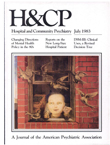A Study of Repeat Visits to a Psychiatric Emergency Room
Abstract
The authors examined the records of 3,824 patients making their first visit to a psychiatric emergency room ofa teaching hospital. Data on the patients who made repeat visits (1 7. 7 percent) were analyzed to determine vanables that may correlate with nepeating for follow-up periods of 90 and 360 days. Although no factors present in the initial visit allowed a useful level of prediction of repeat visits, psychiatric history, cognitive difficulties, and a diagnosis of more severe psychopathology were validated as correlates ofrepeating. Results suggested there were tu'o sub-groups of repeaters: those who repeated within 30 days and who were distinguished from nonrepeaters solely by their previous psychiatric contact, and those who repeated after 30 days and who appeared chronically ill and afflicted with profound psychological, social, and economic problems. implications for the emergency room are discussed.
Access content
To read the fulltext, please use one of the options below to sign in or purchase access.- Personal login
- Institutional Login
- Sign in via OpenAthens
- Register for access
-
Please login/register if you wish to pair your device and check access availability.
Not a subscriber?
PsychiatryOnline subscription options offer access to the DSM-5 library, books, journals, CME, and patient resources. This all-in-one virtual library provides psychiatrists and mental health professionals with key resources for diagnosis, treatment, research, and professional development.
Need more help? PsychiatryOnline Customer Service may be reached by emailing [email protected] or by calling 800-368-5777 (in the U.S.) or 703-907-7322 (outside the U.S.).



